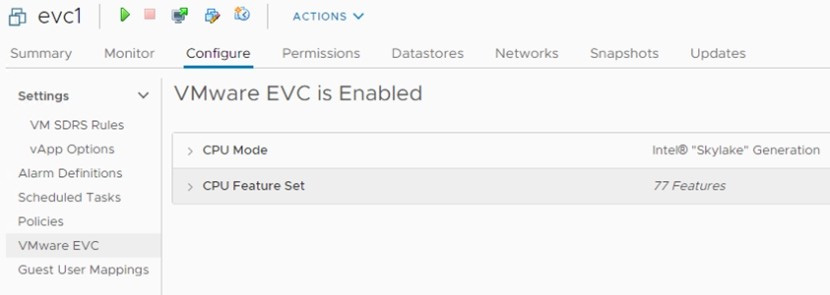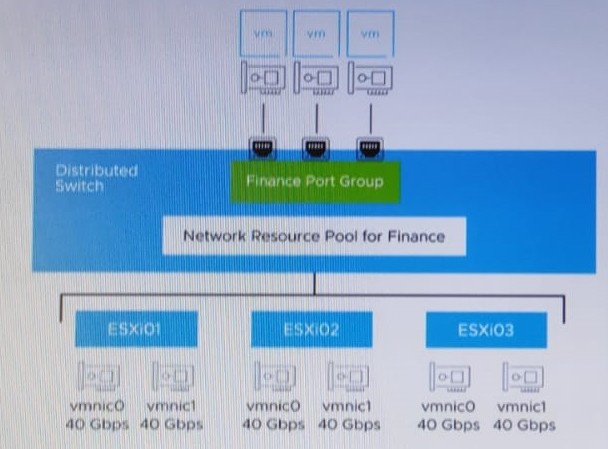Exam Details
Exam Code
:2V0-21.23Exam Name
:VMware vSphere 8.x ProfessionalCertification
:VMware CertificationsVendor
:VMwareTotal Questions
:216 Q&AsLast Updated
:Mar 25, 2025
VMware VMware Certifications 2V0-21.23 Questions & Answers
-
Question 111:
An administrator wants to create virtual machine (VM) templates and store them in a content library. The administrator would like to use the content library to manage different versions of these templates so that reverting to an earlier version is an option.
How should the administrator create these templates?
A. Select a VM in the vCenter inventory. Clone the VM to the content library as a VM template type.
B. Select a VM template in the vCenter inventory. Clone the template to the content library.
C. Export a VM in the vCenter inventory to an OVF template. Import the OVF template into the content library.
D. Convert a VM to a template in the vCenter inventory. Clone the template to the content library.
-
Question 112:
Refer to the exhibit.

An administrator is tasked with adding new capacity to an existing software-defined data center (SDDC).
The SDDC currently hosts two vSphere clusters (ClusterA and ClusterB) with different CPU compatibilities. vSphere vMotion and vSphere Distributed Resource Scheduler (DRS) are currently in use in the SDDC. The new capacity will be implemented by provisioning four ESXi hosts running a new generation of Intel Skylake CPUs. All workload virtual machines (VMs) must support live migration to any cluster in the SDDC.
The administrator noticed the running critical "ever virtual machine (VM) shown in the exhibit is not migrating using vSphere vMotion to the original Clusters A or B.
Which three steps must the administrator take to support this functionality? (Choose three.)
A. Power on the VM.
B. Disable the Enhanced vMotion Compatibility (EVC) on the VM.
C. Reboot the VM.
D. D. Configure the Enhanced vMotion Compatibility (EVC) on vSphere Cluster A and B to support Intel Skylake.
E. Power off the VM.
F. Configure the Enhanced vMotion Compatibility (EVC) on the VM to Intel Skylake.
-
Question 113:
An administrator is responsible for performing maintenance tasks on a vSphere cluster. The cluster has the following configuration:
Identically configured vSphere ESXi hosts (esx01, esx02, esx03 and esx04) All workloads are deployed into a single VMFS datastore provided by the external storage array vSphere High Availability (HA) has not been enabled vSphere Distributed Resource Scheduler (DRS) has not been enabled Currently, a critical production application workload (VM1) is running on esx01.
Given this scenario, which two actions are required to ensure VM1 continues to run when esx01 is placed into maintenance mode? (Choose two.)
A. Fully automated DRS must be enabled on the cluster so that VM1 will be automatically migrated to another host within the cluster when esx01 is placed into maintenance mode.
B. VM1 must be manually shut down and cold migrated to another host within the cluster using vSphere vMotion before esx01 is placed into maintenance mode.
C. vSphere HA must be enabled on the cluster so that VM1 will be automatically migrated to another host within the cluster when esx01 is placed into maintenance mode.
D. VM1 must be manually live migrated to another host within the cluster using vSphere vMotion before esx01 is placed into maintenance mode.
E. VM1 must be manually migrated to another host within the cluster using vSphere Storage vMotion before esx01 is placed into maintenance mode.
-
Question 114:
A company has two sites: Site A and Site B. The administrator would like to manage the VMware vCenter inventories in both sites from a single vSphere Client session.
Which vCenter feature must be configured?
A. VMware Certificate Authority
B. VMware Site Recovery Manager
C. vCenter Single Sign-On
D. Enhanced Linked Mode
-
Question 115:
An administrator is tasked with configuring vSphere Trust Authority. The administrator has completed the following steps:
Set up the workstation Enabled the Trust Authority Administrator Enabled the Trust Authority State Collected information about the ESXi hosts and vCenter to be trusted
Which step does the administrator need to complete next?
A. Import the Trusted Host information to the Trust Authority Cluster
B. Import the Trusted Cluster information to the Trusted Hosts
C. Create the Key Provider on the Trusted Cluster
D. Import the Trusted Host information to the Trusted Cluster
-
Question 116:
An administrator needs better performance and near-zero CPU utilization from the ESXI hosts for networking functions and processing. The administrator creates a new vSphere Distributed Switch and enables network offloads compatibility. Which solution would help achieve this goal?
A. VSphere Distributed Services Engine
B. Data Processing Units (DPUs)
C. vSphere Network I/O Control
D. Universal Passthrough version 2
-
Question 117:
Refer to the exhibit.

An administrator set up the following configuration:
The distributed switch has three ESXi hosts, and each host has two 40 Gbps NICs. The amount of bandwidth reserved for virtual machine (VM) traffic is 6 Gbps.
The administrator wants to guarantee that VMs in the Finance distributed port group can access 50 percent of the available reserved bandwidth for VM traffic. k
Given this scenario, what should the size (in Gbps) of the Finance network resource pool be?
A. 18
B. 80
C. 36
D. 120
-
Question 118:
An administrator is tasked with migrating a single virtual machine (VM) from an existing VMware vCenter to a secure environment where corporate security policy requires that all VMs be encrypted. The secure environment consists of a dedicated vCenter instance with a 4-node vSphere cluster and already contains a number of encrypted VMs.
Which two steps must the administrator take to ensure the migration is a success? (Choose two.)
A. Ensure that the source and destination vCenter instances share the same Key Management Server (KMS).
B. Ensure that Encrypted vMotion Is turned off for the VM.
C. Ensure that the VM is encrypted before attempting the migration.
D. Ensure that the VM is powered off before attempting the migration.
E. Ensure that the source and destination vCenter Servers have a different Key Management Server (KMS).
-
Question 119:
An administrator is tasked with implementing a backup solution capable of backing up the Su-pervisor cluster, vSphere Pods, and persistent volumes.
Which two solutions must be used to meet this requirement? (Choose two.)
A. VMware vCenter
B. Standalone Velero and Restic
C. NSX-T Manager
D. vSphere Host Client
E. Velero Plugin for vSphere
-
Question 120:
An administrator is completing the configuration of a new vSphere cluster and has enabled vSphere High Availability (HA) and vSphere Distributed Resource Scheduler (DRS).
After adding the ESXi hosts to the cluster, which networking information will the administrator be prompted to provide when using the Cluster Quickstart workflow?
A. vMotion networking
B. Management networking
C. vSAN networking
D. Virtual machine networking
Related Exams:
1V0-21.20
Associate VMware Data Center Virtualization1V0-31.21
Associate VMware Cloud Management and Automation1V0-41.20
Associate VMware Network Virtualization1V0-61.21
Associate VMware Digital Workspace1V0-71.21
Associate VMware Application Modernization1V0-81.20
Associate VMware Security2V0-21.20
Professional VMware vSphere 7.x2V0-21.23
VMware vSphere 8.x Professional2V0-31.21
Professional VMware vRealize Automation 8.32V0-31.23
VMware Aria Automation 8.10 Professional
Tips on How to Prepare for the Exams
Nowadays, the certification exams become more and more important and required by more and more enterprises when applying for a job. But how to prepare for the exam effectively? How to prepare for the exam in a short time with less efforts? How to get a ideal result and how to find the most reliable resources? Here on Vcedump.com, you will find all the answers. Vcedump.com provide not only VMware exam questions, answers and explanations but also complete assistance on your exam preparation and certification application. If you are confused on your 2V0-21.23 exam preparations and VMware certification application, do not hesitate to visit our Vcedump.com to find your solutions here.